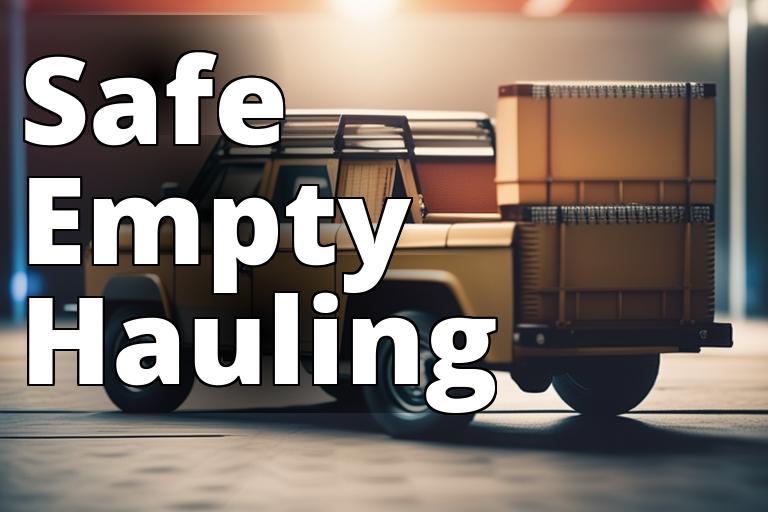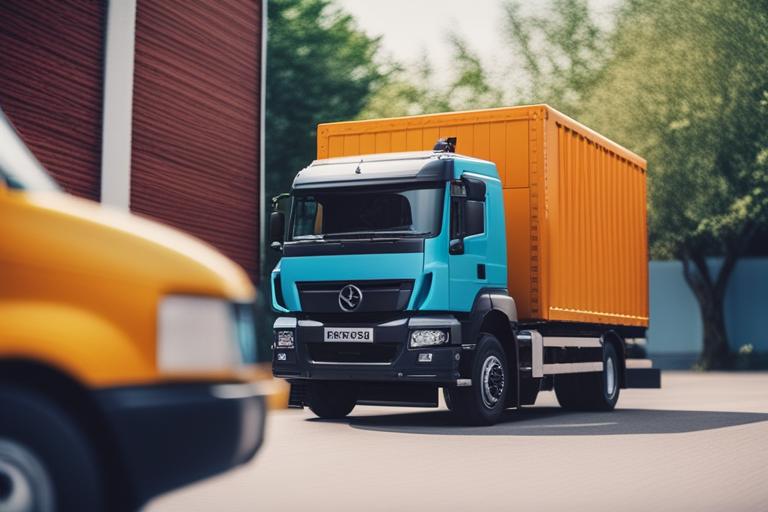
Are you considering driving with an empty cargo box? An empty cargo box can provide several benefits, such as improved fuel efficiency, better handling and stability, and increased visibility. However, it’s important to keep in mind the safety concerns that come with it as well. This article will provide information on the benefits and safety concerns of driving with an empty cargo box, as well as tips for safe driving and choosing the right cargo box for your vehicle.
Driving with an Empty Cargo Box: What You Need to Know
- Benefits of driving with an empty cargo box, including improved fuel efficiency, better handling, and increased visibility
- Safety concerns related to driving with an empty cargo box, such as potential hazards for other drivers and reduced braking ability
- Tips for safe driving with an empty cargo box, including securing the box and driving slower in adverse weather conditions

Benefits of Driving with an Empty Cargo Box
Driving with an empty cargo box can provide several benefits, including:
Improved Fuel Efficiency Due to Reduced Weight
One of the most significant benefits of driving with an empty cargo box is improved fuel efficiency. An empty cargo box means less weight, which leads to better gas mileage. When you’re not carrying any cargo, you’re driving a lighter vehicle, which requires less energy to move. This can lead to significant savings in fuel costs over time.
Better Handling and Stability, Especially in Windy Conditions
Another benefit of driving with an empty cargo box is improved handling and stability, especially in windy conditions. When your cargo box is empty, there is less weight on the back of your vehicle, which can reduce the effects of wind gusts and improve your vehicle’s stability. This can make your ride smoother and more comfortable, especially if you frequently drive in windy areas.
Increased Visibility Due to Unobstructed Rearview Mirror
Another advantage of driving with an empty cargo box is increased visibility. When you don’t have anything in your cargo box, your rearview mirror is unobstructed, which means you have better visibility of what’s behind you. This can help you avoid accidents and navigate traffic more safely.
Reduced Wear and Tear on the Vehicle’s Suspension
Driving with an empty cargo box can also reduce wear and tear on your vehicle’s suspension. When you’re not carrying any cargo, there is less weight on your vehicle, which means less stress on your suspension system. This can help prolong the life of your vehicle and reduce maintenance costs over time.
Other Benefits of Using an Empty Cargo Box
In addition to the benefits mentioned above, there are other advantages to using an empty cargo box. For example, an empty cargo box can provide additional passenger space in your vehicle. This can be especially useful if you have a large family or frequently transport passengers. Additionally, an empty cargo box can make it easier to load and unload items from your vehicle.

Safety Concerns Related to Driving with an Empty Cargo Box
While there are several benefits to driving with an empty cargo box, it is important to keep in mind the safety concerns that come with it as well. Some of these safety concerns include:
Potential for Items to Become Loose and Fall Out of the Box, Causing Hazards for Other Drivers
One of the biggest safety concerns related to driving with an empty cargo box is the potential for items to become loose and fall out of the box. If you don’t secure your cargo box properly, items can shift and fall out, creating hazards for other drivers on the road. This can cause accidents and lead to injuries or property damage.
Reduced Braking Ability, Especially in Wet or Slippery Conditions
Another safety concern related to driving with an empty cargo box is reduced braking ability, especially in wet or slippery conditions. When your cargo box is empty, there is less weight on your vehicle, which means you may not be able to brake as quickly or effectively as you would with a loaded cargo box. This can increase your risk of accidents, especially in hazardous driving conditions.
Increased Risk of Rollover if the Vehicle is Top-Heavy
An empty cargo box can also increase the risk of rollover if your vehicle is top-heavy. When your cargo box is empty, there is less weight on the back of your vehicle, which can cause it to become top-heavy and unstable. This can increase your risk of rollover, especially if you’re driving at high speeds or making sharp turns.
Legal Requirements for Securing Loads in Some States and the Consequences of Failing to Do So
It’s important to note that some states have legal requirements for securing loads on vehicles, including empty cargo boxes. Failing to secure your cargo box properly can result in fines and other legal consequences. It’s important to check the laws in your state and make sure you’re in compliance to avoid any legal issues.

Tips for Safe Driving with an Empty Cargo Box
To ensure safe driving with an empty cargo box, follow these tips:
Secure the Box with Tie-Downs or Straps to Prevent It from Shifting or Becoming Loose
The most important thing you can do to ensure safe driving with an empty cargo box is to secure it properly. Use tie-downs or straps to keep your cargo box in place and prevent it from shifting or becoming loose while you’re driving.
Drive Slower and More Cautiously, Especially on Turns and in Adverse Weather Conditions
When driving with an empty cargo box, it’s important to drive slower and more cautiously, especially on turns and in adverse weather conditions. This will give you more time to react and reduce your risk of accidents.
Avoid Overloading the Box with Items That Could Increase the Risk of Rollover or Cause Other Safety Hazards
When using your cargo box, avoid overloading it with items that could increase the risk of rollover or cause other safety hazards. Be mindful of the weight limit and make sure you’re not exceeding it.
Consider Using a Bed Liner or Mat to Reduce Sliding and Shifting of Items
To further reduce the risk of items becoming loose or shifting in your cargo box, consider using a bed liner or mat. This will help keep items in place and reduce the risk of accidents.
Be Aware of the Weight Limit for the Cargo Box and Do Not Exceed It
It’s important to be aware of the weight limit for your cargo box and make sure you’re not exceeding it. Overloading your cargo box can increase your risk of accidents and cause damage to your vehicle.

Choosing an Empty Cargo Box and Installing It Safely
When choosing an empty cargo box, there are several factors to consider, such as size, material, and compatibility with your vehicle. It’s important to choose a cargo box that is the right size for your needs and compatible with your vehicle’s make and model. Additionally, make sure the material is durable and able to withstand the elements.
To install your cargo box safely, follow these step-by-step instructions:
- Position the cargo box on the bed of your vehicle.
- Use the provided mounting hardware to secure the cargo box to the bed of your vehicle.
- Use tie-downs or straps to secure the cargo box to the bed of your vehicle.
- Test the cargo box to make sure it is secure and does not shift or become loose while you’re driving.
Personal Story: The Importance of Securing Your Empty Cargo Box
I learned the hard way about the importance of securing my empty cargo box while driving on the highway. Last summer, I was driving my pickup truck with an empty cargo box to pick up some furniture. I didn’t bother to tie it down, thinking that since it was empty, it would be fine. But I was wrong.
As I was driving on the highway, I suddenly heard a loud noise and saw something fly out of my rearview mirror. I quickly realized that my empty cargo box had become loose and had fallen off my truck, causing a dangerous hazard for other drivers on the road. Luckily, no one was hurt, but I was terrified and embarrassed by my mistake.
After that incident, I learned my lesson and always make sure to secure my empty cargo box with tie-downs or straps, even if it’s empty. I also make sure to drive slower and more cautiously, especially on turns and in adverse weather conditions. It’s not worth risking my safety or the safety of others on the road for the sake of convenience.
I hope my experience serves as a reminder to other drivers to always secure their empty cargo boxes and to drive responsibly.

Frequently Asked Questions About Driving with an Empty Cargo Box
Can I Drive with an Empty Cargo Box on the Highway?
Yes, you can drive with an empty cargo box on the highway. However, it’s important to secure the cargo box properly and follow safe driving practices.
What Should I Do if I Have to Drive with an Empty Cargo Box in Windy Conditions?
If you have to drive with an empty cargo box in windy conditions, drive slower and more cautiously. Additionally, make sure your cargo box is secured properly to reduce the effects of wind gusts.
Are There Any Legal Requirements for Using an Empty Cargo Box?
Some states have legal requirements for securing loads on vehicles, including empty cargo boxes. It’s important to check the laws in your state and make sure you’re in compliance to avoid any legal issues.
What Is the Weight Limit for an Empty Cargo Box?
The weight limit for an empty cargo box varies depending on the make and model of your vehicle. It’s important to check your vehicle’s owner’s manual to determine the weight limit for your cargo box.
Can I Use an Empty Cargo Box for Other Purposes Besides Hauling Cargo?
Yes, you can use an empty cargo box for other purposes besides hauling cargo. For example, you can use it to transport sports equipment or camping gear.
Conclusion
Driving with an empty cargo box can provide several benefits, such as improved fuel efficiency, better handling and stability, and increased visibility. However, it’s important to keep in mind the safety concerns that come with it as well, such as the potential for items to become loose and fall out of the box. To ensure safe driving with an empty cargo box, make sure to secure it properly, drive slower and more cautiously, and avoid overloading it with items that could increase the risk of rollover or cause other safety hazards. Additionally, choose a cargo box that is the right size and material for your needs and compatible with your vehicle, and install it safely and securely. By following these tips, you can enjoy the benefits of driving with an empty cargo box while minimizing the risks.








